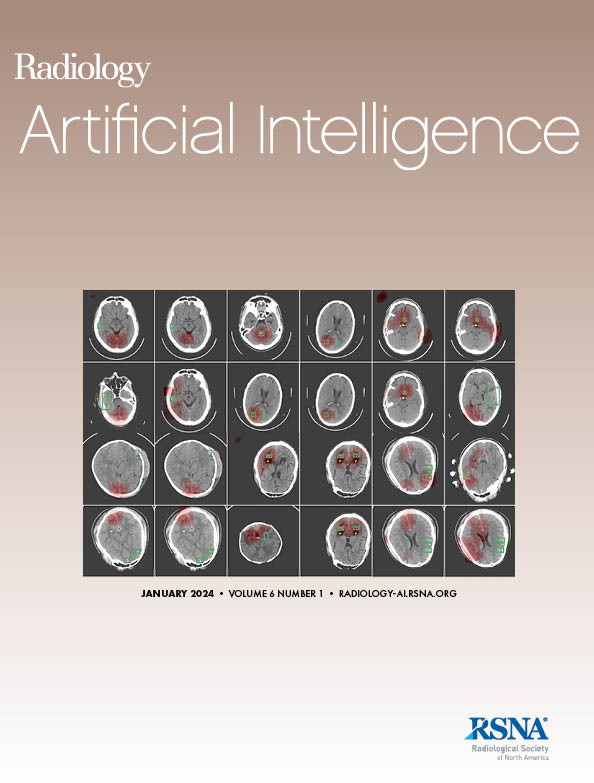Marit A Martiniussen, Marthe Larsen, Tone Hovda, Merete U Kristiansen, Fredrik A Dahl, Line Eikvil, Olav Brautaset, Atle Bjørnerud, Vessela Kristensen, Marie B Bergan, Solveig Hofvind
求助PDF
{"title":"Performance of Two Deep Learning-based AI Models for Breast Cancer Detection and Localization on Screening Mammograms from BreastScreen Norway.","authors":"Marit A Martiniussen, Marthe Larsen, Tone Hovda, Merete U Kristiansen, Fredrik A Dahl, Line Eikvil, Olav Brautaset, Atle Bjørnerud, Vessela Kristensen, Marie B Bergan, Solveig Hofvind","doi":"10.1148/ryai.240039","DOIUrl":null,"url":null,"abstract":"<p><p>Purpose To evaluate cancer detection and marker placement accuracy of two artificial intelligence (AI) models developed for interpretation of screening mammograms. Materials and Methods This retrospective study included data from 129 434 screening examinations (all female patients; mean age, 59.2 years ± 5.8 [SD]) performed between January 2008 and December 2018 in BreastScreen Norway. Model A was commercially available and model B was an in-house model. Area under the receiver operating characteristic curve (AUC) with 95% CIs were calculated. The study defined 3.2% and 11.1% of the examinations with the highest AI scores as positive, threshold 1 and 2, respectively. A radiologic review assessed location of AI markings and classified interval cancers as true or false negative. Results The AUC value was 0.93 (95% CI: 0.92, 0.94) for model A and B when including screen-detected and interval cancers. Model A identified 82.5% (611 of 741) of the screen-detected cancers at threshold 1 and 92.4% (685 of 741) at threshold 2. Model B identified 81.8% (606 of 741) at threshold 1 and 93.7% (694 of 741) at threshold 2. The AI markings were correctly localized for all screen-detected cancers identified by both models and 82% (56 of 68) of the interval cancers for model A and 79% (54 of 68) for model B. At the review, 21.6% (45 of 208) of the interval cancers were identified at the preceding screening by either or both models, correctly localized and classified as false negative (<i>n</i> = 17) or with minimal signs of malignancy (<i>n</i> = 28). Conclusion Both AI models showed promising performance for cancer detection on screening mammograms. The AI markings corresponded well to the true cancer locations. <b>Keywords:</b> Breast, Mammography, Screening, Computed-aided Diagnosis <i>Supplemental material is available for this article.</i> © RSNA, 2025 See also commentary by Cadrin-Chênevert in this issue.</p>","PeriodicalId":29787,"journal":{"name":"Radiology-Artificial Intelligence","volume":" ","pages":"e240039"},"PeriodicalIF":13.2000,"publicationDate":"2025-05-01","publicationTypes":"Journal Article","fieldsOfStudy":null,"isOpenAccess":false,"openAccessPdf":"","citationCount":"0","resultStr":null,"platform":"Semanticscholar","paperid":null,"PeriodicalName":"Radiology-Artificial Intelligence","FirstCategoryId":"1085","ListUrlMain":"https://doi.org/10.1148/ryai.240039","RegionNum":0,"RegionCategory":null,"ArticlePicture":[],"TitleCN":null,"AbstractTextCN":null,"PMCID":null,"EPubDate":"","PubModel":"","JCR":"Q1","JCRName":"COMPUTER SCIENCE, ARTIFICIAL INTELLIGENCE","Score":null,"Total":0}
引用次数: 0
引用
批量引用
Abstract
Purpose To evaluate cancer detection and marker placement accuracy of two artificial intelligence (AI) models developed for interpretation of screening mammograms. Materials and Methods This retrospective study included data from 129 434 screening examinations (all female patients; mean age, 59.2 years ± 5.8 [SD]) performed between January 2008 and December 2018 in BreastScreen Norway. Model A was commercially available and model B was an in-house model. Area under the receiver operating characteristic curve (AUC) with 95% CIs were calculated. The study defined 3.2% and 11.1% of the examinations with the highest AI scores as positive, threshold 1 and 2, respectively. A radiologic review assessed location of AI markings and classified interval cancers as true or false negative. Results The AUC value was 0.93 (95% CI: 0.92, 0.94) for model A and B when including screen-detected and interval cancers. Model A identified 82.5% (611 of 741) of the screen-detected cancers at threshold 1 and 92.4% (685 of 741) at threshold 2. Model B identified 81.8% (606 of 741) at threshold 1 and 93.7% (694 of 741) at threshold 2. The AI markings were correctly localized for all screen-detected cancers identified by both models and 82% (56 of 68) of the interval cancers for model A and 79% (54 of 68) for model B. At the review, 21.6% (45 of 208) of the interval cancers were identified at the preceding screening by either or both models, correctly localized and classified as false negative (n = 17) or with minimal signs of malignancy (n = 28). Conclusion Both AI models showed promising performance for cancer detection on screening mammograms. The AI markings corresponded well to the true cancer locations. Keywords: Breast, Mammography, Screening, Computed-aided Diagnosis Supplemental material is available for this article. © RSNA, 2025 See also commentary by Cadrin-Chênevert in this issue.
两种基于深度学习的人工智能模型在筛查乳房x光片上的乳腺癌检测和定位性能
“刚刚接受”的论文经过了全面的同行评审,并已被接受发表在《放射学:人工智能》杂志上。这篇文章将经过编辑,布局和校样审查,然后在其最终版本出版。请注意,在最终编辑文章的制作过程中,可能会发现可能影响内容的错误。目的评价两种人工智能(AI)模型对筛查性乳房x线照片的诊断和标记物定位准确性。材料和方法本回顾性研究包括2008年1月至2018年12月在挪威乳房筛查中心进行的124934次筛查检查(均为女性,平均年龄59.2岁,SD = 5.8)的数据。A型是市售型,B型是内部模型。计算受试者工作特征曲线下面积(AUC)和95%置信区间(ci)。该研究将人工智能得分最高的检查分别定义为3.2%和11.1%为阳性,阈值为1和2。放射学检查评估了AI标记的位置,并将间隔期癌症分类为真阴性或假阴性。结果当包括筛检癌和间隔期癌时,模型A和B的AUC为0.93 (95% CI: 0.92-0.94)。模型A在阈值1和阈值2分别识别出82.5%(611/741)和92.4%(685/741)的筛检癌。型号B分别为81.8%(606/741)和93.7%(694/741)。AI标记对两种模型识别的所有筛查检测到的癌症都正确定位,对模型A和模型b的间隔癌症分别有82%(56/68)和79%(54/68)。在回顾中,21.6%(45/208)的间隔癌症在之前的筛查中被一种或两种模型识别出来,正确定位并归类为假阴性(n = 17)或具有最小恶性肿瘤迹象(n = 28)。结论两种人工智能模型在乳房x线筛查中均表现出良好的癌症检测效果。人工智能标记与真实的癌症位置非常吻合。©RSNA, 2025年。
本文章由计算机程序翻译,如有差异,请以英文原文为准。

 求助内容:
求助内容: 应助结果提醒方式:
应助结果提醒方式:


